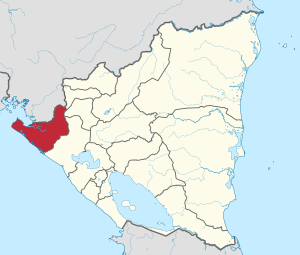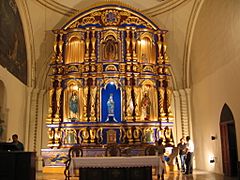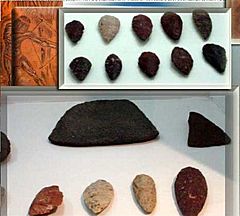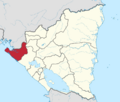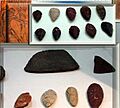Chinandega facts for kids
Quick facts for kids
Chinandega
|
|||
|---|---|---|---|
|
Municipality
|
|||
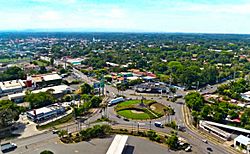
Chinandega main roundabout.
|
|||
|
|||
| Country | |||
| Department | Chinandega Department | ||
| Area | |||
| • Municipality | 687 km2 (265 sq mi) | ||
| Population
(2022 estimate)
|
|||
| • Municipality | 137,539 | ||
| • Density | 200.20/km2 (518.5/sq mi) | ||
| • Urban | 115,067 (6th Nicaragua) | ||
Chinandega (Spanish pronunciation: [tʃinanˈdeɣa]) is an important city in Nicaragua. It's the main city of the Chinandega Department. It is also the center of the area around it. Chinandega is the second most important city in Nicaragua for its economy. It is also the sixth largest city in the country. About 115,067 people live in the city itself (2022 estimate). The whole area around the city has about 137,539 people.
Chinandega is located about 134 kilometers (83 miles) northwest of Managua, the capital of Nicaragua. It is also about 72 kilometers (45 miles) southwest of El Guasaule, which is on the border with Honduras. The city is quite close to the Pacific Ocean, only about 20 kilometers (12 miles) away.
The city has its own airport, called Chinandega Airport.
The area around Chinandega is known for its farms. They grow crops like oil, flour, peanuts, and sugarcane. They also produce shrimp and make liquors. Because it's in a low area in the tropics, Chinandega has warm and humid weather.
Contents
Exploring Chinandega's Geography
Chinandega is located near Nicaragua's border with Honduras. The main highway, CA-1 (Pan-American Highway), passes through it. The Chinandega Department covers an area of 4,929 square kilometers (1,903 sq mi). About 378,970 people live in this department. It includes thirteen smaller towns and areas called municipalities. Chinandega city is the main one. Other municipalities are El Viejo, Corinto, Chichigalpa, Posoltega, El Realejo, Puerto Morazán, Villanueva, Somotillo, Santo Tomás del Norte, San Juan de Cinco Pinos, San Pedro del Norte and San Francisco del Norte.
The department has many beautiful places. You can find beaches, nature reserves, and old towns. There are also mangroves (special trees that grow in salt water) and very old churches. The tallest volcano in Nicaragua, San Cristóbal, is here. Other volcanoes like El Chonco, Moyotepe, and Casita are also nearby. Further east, you can see the Cosigüina volcano, which forms a peninsula.
Chinandega is a big center for farming. Farmers grow sugarcane, bananas, peanuts, sesame seeds, cashews, oranges, and other grains. It's also a place where people catch shrimp and fish. The city makes salt and leather goods. The biggest sugar mills and the famous Flor de Caña rum factory are also located here.
Some famous people from this area include Salomón Ibarra Mayorga, who wrote Nicaragua's national anthem. Tino López Guerra was a composer. The priest Tomás Ruiz and athletes Vicente Padilla and Próspero González are also from here.
Chinandega's Climate
Chinandega usually has a clear dry season. It has a tropical savanna climate. This means it's generally hot all year. There is a rainy season and a dry season.
| Climate data for Chinandega (1971–1990) | |||||||||||||
|---|---|---|---|---|---|---|---|---|---|---|---|---|---|
| Month | Jan | Feb | Mar | Apr | May | Jun | Jul | Aug | Sep | Oct | Nov | Dec | Year |
| Mean daily maximum °C (°F) | 34.5 (94.1) |
35.4 (95.7) |
36.1 (97.0) |
36.4 (97.5) |
34.2 (93.6) |
32.6 (90.7) |
33.4 (92.1) |
33.2 (91.8) |
31.9 (89.4) |
31.9 (89.4) |
32.4 (90.3) |
33.4 (92.1) |
33.8 (92.8) |
| Daily mean °C (°F) | 26.4 (79.5) |
27.2 (81.0) |
28.0 (82.4) |
28.7 (83.7) |
27.9 (82.2) |
26.6 (79.9) |
26.9 (80.4) |
26.8 (80.2) |
26.0 (78.8) |
26.0 (78.8) |
26.1 (79.0) |
26.1 (79.0) |
26.9 (80.4) |
| Mean daily minimum °C (°F) | 18.9 (66.0) |
19.4 (66.9) |
20.6 (69.1) |
22.3 (72.1) |
23.3 (73.9) |
22.7 (72.9) |
22.2 (72.0) |
22.2 (72.0) |
22.3 (72.1) |
22.1 (71.8) |
21.1 (70.0) |
19.6 (67.3) |
21.4 (70.5) |
| Average precipitation mm (inches) | 1 (0.0) |
0 (0) |
7 (0.3) |
14 (0.6) |
309 (12.2) |
313 (12.3) |
193 (7.6) |
271 (10.7) |
404 (15.9) |
330 (13.0) |
63 (2.5) |
84 (3.3) |
1,988 (78.3) |
| Average precipitation days (≥ 1.0 mm) | 0 | 0 | 1 | 2 | 12 | 16 | 13 | 16 | 20 | 18 | 6 | 1 | 105 |
| Mean monthly sunshine hours | 265.3 | 248.5 | 261.8 | 206.8 | 183.7 | 168.2 | 204.2 | 199.9 | 173.9 | 204.2 | 211.0 | 255.2 | 2,582.7 |
| Source: National Oceanic and Atmospheric Administration | |||||||||||||
Chinandega's History
Chinandega has a few nicknames. People call it "the City of Oranges" (Ciudad de las Naranjas) and "the Hot City" (Ciudad Cálida). Its name comes from the Nahuatl language. The exact meaning is not fully known. It might mean "place surrounded by reeds."
During the time of the Spanish Empire, Chinandega was a small city. But it grew in importance because it was in a fertile flat area. It also became a center for trade. A Spanish writer, Friar Antonio Vázquez Espinoza, visited Chinandega in 1613. He wrote that the town was "comprised of many Indians, plentiful corn, and all of the fruits of the earth, and appears to be a piece of paradise."
Chinandega officially became a settlement in 1796. An engineer named Antonio Rojas planned the city. On March 30, 1835, a law was made to hold a fair there every year on December 8.
The city received the title of "town" (villa) on March 15, 1836. This happened during the time of José Núñez. Later, on September 2, 1839, it officially became a "city."
On November 1, 1998, a big flood hit Chinandega. This was caused by Hurricane Mitch. Many thousands of people lost their homes. The flood also damaged buildings and roads. Some of these damages were still not fixed by 2009.
Important Churches in Chinandega
Chinandega has several historic churches. They show the city's long history.
Our Lady Santa Ana Parish
This church is in the center of the city. It is built in the Romanesque style. It has stood strong through many storms, earthquakes, and wars for over a century. An earthquake in 1885 badly damaged the church. It was then rebuilt to look as it does today. This church is not in the exact spot of the original 17th-century building.
Old papers from 1751 describe the church. They say it had "three naves on the river, with its sacristy and choir close by, two small bells, limestone walls, and tiled floors." Two old doors in the Antigueño style are on the north and south sides of the church. These doors survived all the earthquakes, even one in 1925 that damaged the front and towers.
The feast day of Saint Anne is celebrated here every year on July 26. The church has been fixed up to look like its old colonial self. People hope it will become the main church for a new diocese, which would make it a cathedral.
El Calvario Parish
El Calvario Parish is in a neighborhood with the same name. Bishop Monsignor Manuel Ulloa y Calvo built it in 1874. The first building was made of adobe (a type of mud brick). But an earthquake destroyed it on October 11, 1885. It was later rebuilt. The church's special day is for the Holy Name of Jesus. It is celebrated on the last Sunday of January each year. On May 17, they also celebrate the feast day of Saint Pascal Baylon. The COEN Foundation recently helped restore this church.
Sanctuary of Our Lady of Guadalupe
This church is newer. It started with a building in 1855, but an earthquake in 1885 destroyed it. It was first built as a gift to Our Lady of Guadalupe during a time when many people were sick with cholera. After the sickness ended, an image of Our Lady of Guadalupe was first shown in the church on December 25, 1856. Pope Pius IX later gave the church the special title of "sanctuary." It was the first church in Central America to get this honor. The COEN Foundation also restored this church. Its main feast day is on December 12. There are also special walks (processions) during Holy Week that start here.
Saint Anthony Church (Iglesia San Antonio)
This church was also badly damaged by the 1885 earthquake. After that, it was made bigger. This church was often used by the city's rich families. Fancy weddings for these families were held inside its walls. In 1923, the Franciscans (a group of religious people) came to the church. They completely rebuilt it. Its main feast day is on June 13 every year. There is also a procession held on January 1 each year.
Old Buildings in Chinandega
Chinandega has many buildings from the colonial period. However, it doesn't have as many as cities like León and Granada. This is because many buildings were damaged in 1928. This happened during a bombardment (when bombs are dropped) by forces who were fighting against the government. Most of the city was destroyed, but the churches were not harmed. Unlike León and Granada, Chinandega does not have special rules to protect its old colonial buildings.
Chinandega's Culture
Chinandega has a rich history and culture. This goes back to before the Spanish arrived. At that time, different Mesoamerican groups lived here. They might have come from the north, possibly from what is now Mexico.
There is a museum in the city called "Enrique Mantica Deshon." It has 1,200 old archaeological items. These items are from before Christopher Columbus came to the Americas. The city also has a theater called "Rodrigo Callejas." It can hold 400 people for shows and events.
Sports in Chinandega
Chinandega is home to two football (soccer) clubs. Both of these teams have played in Nicaragua's top league recently. They are Chinandega FC and VCP Chinandega. They both play at the Estadio Efraín Tijerino Mazariego. This stadium is in the northwest part of town, near the airport.
The city also has a baseball team called Tigres de Chinandega. They are part of the Nicaragua Professional Baseball League. Several players who have played in Major League Baseball in the United States have been members of Los Tigres. One example is Mark Minicozzi.
Famous People from Chinandega
- Reynaldo Aguado Montealegre (born 1960), a person who works for human rights.
- Carlos Alonso (born 1979), a former football (soccer) player.
- Elí Altamirano (1934-2006), a politician and leader of workers' groups.
- Russel Carrero (1950–1990), an Olympic runner.
- Oswaldo Mairena (born 1975), a former baseball pitcher for the Chicago Cubs and Florida Marlins.
- Hermógenes L. Mora (born 1979), a poet and writer.
- Ana Violeta Navarro-Cárdenas (born 1971), a political expert and commentator.
- Vicente Padilla (born 1977), a former baseball pitcher for teams like the Philadelphia Phillies and Boston Red Sox.
- Ileana Rodríguez (born 1939), a university professor who studies Latin America.
- Bismarck Veliz (born 1993), a football (soccer) player.
- Samuel Wilson (born 1983), a football (soccer) player.
Images for kids
See also
 In Spanish: Chinandega para niños
In Spanish: Chinandega para niños





